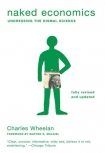Naked Economics, Wheelan, Charles [open ebook .txt] 📗

Book online «Naked Economics, Wheelan, Charles [open ebook .txt] 📗». Author Wheelan, Charles
Productivity growth depends on investment—in physical capital, in human capital, in research and development, and even in things like more effective government institutions. These investments require that we give up consumption in the present in order to be able to consume more in the future. If you skip buying a BMW and invest in a college education instead, your future income will be higher. Similarly, a software company may forgo paying its shareholders a dividend and plow its profits back into the development of a new, better product. The government may collect taxes (depriving us of some current consumption) to fund research in genetics that improves our health in the future. In each case, we spend resources now so that we will become more productive later. When we turn to the macroeconomy—our study of the economy as a whole—one important concern will be whether or not we are investing enough as a nation to continue growing our standard of living.
Our legal, regulatory, and tax structures also affect productivity growth. High taxes, bad government, poorly defined property rights, or excessive regulation can diminish or eliminate the incentive to make productive investments. Collective farms, for example, are a very bad way to organize agriculture. Social factors, such as discrimination, can profoundly affect productivity. A society that does not educate its women or that denies opportunities to members of a particular race or caste or tribe is leaving a vast resource fallow. Productivity growth also depends a great deal on innovation and technological progress, neither of which is understood perfectly. Why did the Internet explode onto the scene in the mid-1990s rather than the late 1970s? How is it that we have cracked the human genome yet we still do not have a cheap source of clean energy? In short, fostering productivity growth is like raising children: We know what kinds of things are important even if there is no blueprint for raising an Olympic athlete or a Harvard scholar.
The study of human capital has profound implications for public policy. Most important, it can tell us why we haven’t all starved to death. The earth’s population has grown to six billion; how have we been able to feed so many mouths? In the eighteenth century, Thomas Malthus famously predicted a dim future for humankind because he believed that as society grew richer, it would continuously squander those gains through population growth—having more children. These additional mouths would gobble up the surplus. In his view, humankind was destined to live on the brink of subsistence, recklessly procreating during the good times and then starving during the bad. As Paul Krugman has pointed out, for fifty-five of the last fifty-seven centuries, Malthus was right. The world population grew, but the human condition did not change significantly.
Only with the advent of the Industrial Revolution did people begin to grow steadily richer. Even then, Malthus was not far off the mark. As Gary Becker points out, “Parents did spend more on children when their incomes rose—as Malthus predicted—but they spent a lot more on each child and had fewer children, as human capital theory predicts.”8 The economic transformations of the Industrial Revolution, namely the large productivity gains, made parents’ time more expensive. As the advantages of having more children declined, people began investing their rising incomes in the quality of their children, not merely the quantity.
One of the fallacies of poverty is that developing countries are poor because they have rapid population growth. In fact, the causal relationship is best understood going the other direction: Poor people have many children because the cost of bearing and raising children is low. Birth control, no matter how dependable, works only to the extent that families prefer fewer children. As a result, one of the most potent weapons for fighting population growth is creating better economic opportunities for women, which starts by educating girls. Taiwan doubled the number of girls graduating from high school between 1966 and 1975. Meanwhile, the fertility rate dropped by half. In the developed world, where women have enjoyed an extraordinary range of new economic opportunities for more than a half century, fertility rates have fallen near or below replacement level, which is 2.1 births per woman.
We began this chapter with a discussion of Bill Gates’s home, which is, I am fairly certain, bigger than yours. At the dawn of the third millennium, America is a profoundly unequal place. Is the nation growing more unequal? That answer, by almost any measure, is yes. According to analysis by the Congressional Budget Office, American households in the bottom fifth of the income distribution were earning only 2 percent more in 2004 (adjusted for inflation) than they were in 1979. That’s a quarter century with no real income growth at all. Americans in the middle of the income distribution did better over the same stretch; their average household income grew 15 percent in real terms. Those in the top quintile—the top 20 percent—saw household income growth of 63 percent (adjusted for inflation).9
As America’s longest economic boom in history unfolded, the rich got richer while the poor ran in place, or even got poorer. Wages for male high school dropouts have fallen by roughly a quarter compared to what their dads earned if they were also high school dropouts. The recession that began in 2007 has narrowed the gap between America’s rich and poor slightly (by destroying wealth at the top, not by making the typical worker better off). Most economists would agree that the long-term trend is a growing gap between America’s rich and poor. The most stunning action has been at the top of the top. In 1979, the wealthiest 1 percent of Americans earned 9 percent of the nation’s total income; now they get





Comments (0)